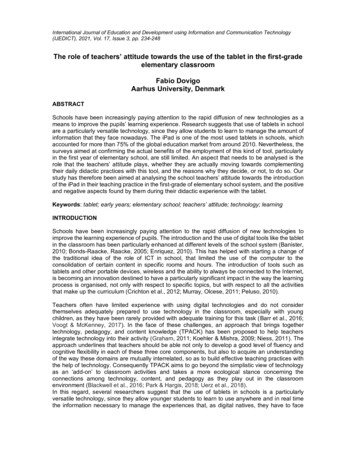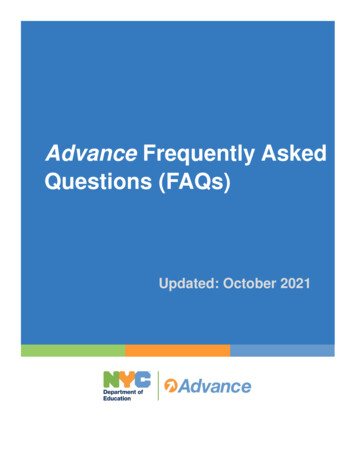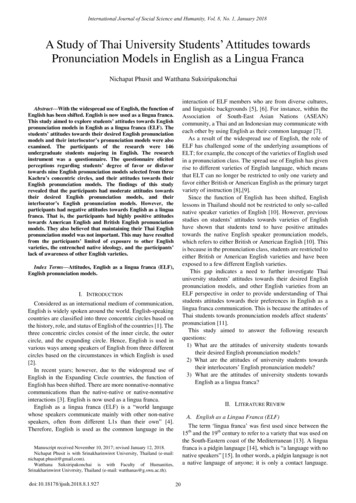
Transcription
International Journal of Education and Development using Information and Communication Technology(IJEDICT), 2021, Vol. 17, Issue 3, pp. 234-248The role of teachers’ attitude towards the use of the tablet in the first-gradeelementary classroomFabio DovigoAarhus University, DenmarkABSTRACTSchools have been increasingly paying attention to the rapid diffusion of new technologies as ameans to improve the pupils’ learning experience. Research suggests that use of tablets in schoolare a particularly versatile technology, since they allow students to learn to manage the amount ofinformation that they face nowadays. The iPad is one of the most used tablets in schools, whichaccounted for more than 75% of the global education market from around 2010. Nevertheless, thesurveys aimed at confirming the actual benefits of the employment of this kind of tool, particularlyin the first year of elementary school, are still limited. An aspect that needs to be analysed is therole that the teachers’ attitude plays, whether they are actually moving towards complementingtheir daily didactic practices with this tool, and the reasons why they decide, or not, to do so. Ourstudy has therefore been aimed at analysing the school teachers’ attitude towards the introductionof the iPad in their teaching practice in the first-grade of elementary school system, and the positiveand negative aspects found by them during their didactic experience with the tablet.Keywords: tablet; early years; elementary school; teachers’ attitude; technology; learningINTRODUCTIONSchools have been increasingly paying attention to the rapid diffusion of new technologies toimprove the learning experience of pupils. The introduction and the use of digital tools like the tabletin the classroom has been particularly enhanced at different levels of the school system (Banister,2010; Bonds-Raacke, Raacke, 2005; Enriquez, 2010). This has helped with starting a change ofthe traditional idea of the role of ICT in school, that limited the use of the computer to theconsolidation of certain content in specific rooms and hours. The introduction of tools such astablets and other portable devices, wireless and the ability to always be connected to the Internet,is becoming an innovation destined to have a particularly significant impact in the way the learningprocess is organised, not only with respect to specific topics, but with respect to all the activitiesthat make up the curriculum (Crichton et al., 2012; Murray, Olcese, 2011; Peluso, 2010).Teachers often have limited experience with using digital technologies and do not considerthemselves adequately prepared to use technology in the classroom, especially with youngchildren, as they have been rarely provided with adequate training for this task (Barr et al., 2016;Voogt & McKenney, 2017). In the face of these challenges, an approach that brings togethertechnology, pedagogy, and content knowledge (TPACK) has been proposed to help teachersintegrate technology into their activity (Graham, 2011; Koehler & Mishra, 2009; Niess, 2011). Theapproach underlines that teachers should be able not only to develop a good level of fluency andcognitive flexibility in each of these three core components, but also to acquire an understandingof the way these domains are mutually interrelated, so as to build effective teaching practices withthe help of technology. Consequently TPACK aims to go beyond the simplistic view of technologyas an ‘add-on’ to classroom activities and takes a more ecological stance concerning theconnections among technology, content, and pedagogy as they play out in the classroomenvironment (Blackwell et al., 2016; Park & Hargis, 2018; Uerz et al., 2018).In this regard, several researchers suggest that the use of tablets in schools is a particularlyversatile technology, since they allow younger students to learn to use anywhere and in real timethe information necessary to manage the experiences that, as digital natives, they have to face
Teachers’ Attitude towards the use of Tablets in the Elementary Classroom235nowadays (Moran et al., 2010). Tablets seem to facilitate personalised learning, since teachers canuse these devices as tools that promote scaffolding in the students’ learning (Lemke et al., 2009).Moreover, tablets offer the opportunity to strengthen the connection between the school and thestudent’s environment, reducing the distance between the students’ activity in the classroom andtheir daily experience outside the school environment, and thus helping pupils to find their way ina world that revolves around digital communication. Considering the relatively reasonable cost oftablets, this is particularly relevant in order to reduce the digital gap that characterises mainlystudents from disadvantaged or low-income families (Melhuish, Falloon, 2010). Moreover the touchscreen mode allows younger pupils to acquire a more direct and intuitive experience than the oneoffered by the mouse (Buxton et al., 1985; Huang et al., 2012). Generally, being cognitively easierto handle, teachers tend to use them more often than they previously used desktop computers orlaptops (Geist, 2012).The iPad is one of the most used tablets in schools, accounting for more than 75% of the educationmarket at the global level from around 2010 (Khaddage, 2013). In order to make this device moreuser-friendly and accessible to all users, Apple has incorporated the principles of the UniversalDesign for Learning in the planning of the more recent devices. This approach is aimed atconsidering the different needs and peculiarities of the students (such as pupils with disabilities).Over the last ten years Apple has introduced a flexible design for users of these devices in termsof objectives, methods, materials, and assessments (Hall et al., 2012). Lastly, the iPad allowsstudents to have access to several educational apps (more than 500.000), the majority of whichwas targeted at preschool and elementary school children (Shuler, 2012; Kucirkova, 2014).Nevertheless, despite the obvious potentialities of using the iPad for learning, the surveys aimedat confirming the actual benefits of the employment of this kind of tool, especially in the early years,are still limited (Banister, 2010; Dezuanni et al., 2015; Falloon & Khoo, 2014; Koile, Singer, 2008).The role that teachers’ attitude plays within the technological innovation promoted by tablets, is anarea for analysis. Analysing this aspect is fundamental to understanding to what extent the use ofnew technologies can really take root in the school environment (Ertmer, 2005; Ottenbreit-Leftwichet al., 2018). Despite the growing diffusion of forms of digital communication in our daily life, surveysshow that inside the school there is still a systematic underuse and a poor integration of theseresources by the teachers in the curriculum (Gray et al., 2010). To investigate the factors thatinfluence the use of the tablet in the daily didactic activity it seems therefore necessary tounderstand the teachers’ point of view with regard to it.LITERATURE REVIEWResearch has highlighted how the teachers’ attitude towards technologies is determined not onlyby institutional constraints, but also by personal factors that include one’s own teaching philosophy,perceptions of and convictions about technology, to what extent one feels at ease with it and howmuch one uses it. This last aspect is the most difficult to address and can have a greater impactthan the institutional constraints on the actual use of technology by the teacher in his/her classroom(Ertmer et al., 1999; Ertmer et al., 2012; Oakley, 2018; Zhao et al., 2002). Moreover, most teachershave been trained on a traditional learning model, and the norms and rules that they haveinternalised thanks to these teaching methods have a strong impact on the way they use, or not,technology (Sheingold, 1991; Russell et al., 2003). Surveys show how teachers’ attitudes towardsand beliefs about technology are closely linked to their didactic practices, and that the teachers thatare more convinced about the potential of technologies in supporting students’ learning are alsothe ones that use them more and in a more diverse way (Blackwell, 2013). Moreover some studiespropose to analyse the teachers’ attitude on the basis of their level of acceptance of/resistance tonew technologies. The incorporation of technology in the classroom often fails because of the nonacceptance by its potential users (Buabeng-Andoh, 2012; Hu et al., 2003). Consequently, even theeffectiveness of the introduction of the iPad in an extensive way in schools depends largely on theextent to which teachers like to use it (El-Gayar, Moran, Hawkes, 2011; Lynch, 2017).
236 IJEDICTBesides the technological and educational potential of the iPad, the key question is thereforewhether teachers are willing to incorporate this device in their daily didactic practices, and thereasons why they decide to do so or not (Brown, Warschauer, 2006; Merchant, 2015). For thisreason, it is also important to understand what informs the teachers’ resistance to the use of thetablet. As a matter of fact, while opening the road to new potentialities for learning, the introductionof a new technology inevitably tends to put into question the pre-existing situation (Lu et al., 2017;Wartella et al., 2010). As any organization, even schools tend to hinder changes, whether they aretechnological or not, through active or passive resistance in the forms of hierarchical structure,current system of rules and decisions, and repeating traditional teaching methods rooted incommon practice (Chubb, Moe, 1990; Collins, Halverson, 2009). Indeed, some newly introducedtechnologies, particularly at the administrative level, are seen by teachers as a further burden onthe already existing bureaucracy and are therefore opposed in a more or less explicit way,especially if they seem to take up time from the didactic activity or hinder what teachers considerto be the efficient functioning of this activity (Buckingham, 2007). The introduction of technologicalinnovations therefore tends to be faced with a considerable level of ‘friction’ from the school andthe single teachers, that can be considered in part responsible for the poor use of these resourcesthat has been pointed out previously (Blackwell et al., 2013).Nevertheless there are also schools and teachers that show interest and invest in the possibilitiesoffered to didactics by using technologies such as the iPad. As a matter of fact, the pompousstatements by the industry that often accompany the presentation of new devices or applicationsfor education help with polarizing the field of attitudes in two opposite positions, the ‘enthusiasts’and the ‘sceptics’ (Collins, Halverson, 2009). This dichotomy does not promote a correct evaluationof the effects that the introduction of these technologies may have in the school (Becker, Ravitz,1999; Cuban et al., 2001). In this sense, an analysis of the teachers’ attitude towards the use of atool like the iPad in their daily teaching practices can help understand which are its real use modelsand the possibilities of being incorporated in the curricular activities (Ifenthaler, Schweinbenz, 2013;Liu et al., 2016; Pynoo, Braak, 2014). Research on this subject has been carried out mainly insecondary schools, whereas studies regarding elementary schools (especially children in the firstgrade) are far fewer (Flewitt et al., 2015; Henderson, Yeow, 2012; Hutchinson, 2012; Kucirkova,2014). The latter highlight the presence of some critical elements, regarding the technical handlingof the devices and the choice of the apps. In relation to this last aspect, Brown and Harmon (2013)highlighted the importance of choice and the need for evaluation of the apps to be made in closecollaboration with the pupils, in regard to supporting their motivation and increasing their ability toselect activities and levels in an increasingly autonomous way.Our study has therefore been aimed at analysing the elementary school teachers’ attitude towardsthe introduction of the iPad in their teaching practice in the first-grade. We will also explore theextent to which there are elements of acceptance and resistance to using this device, and whichare in general, the positive and negative aspects found during their didactic experience.METHODOLOGYOur research was conducted in a comprehensive institute in Lombardy and involved the teachersof four first-grade classes of the same school, attended respectively by 21, 22, 24 and 19 pupilsrespectively. In two of the classes there was a pupil with disabilities attended by a support teacherand a teaching assistant. There were 12 non-Italian students, evenly distributed in each class. Allof the pupils were second-generation bilinguals, except for one pupil of Indian origin that had beenput in one of the classes after the beginning of the school year.
Teachers’ Attitude towards the use of Tablets in the Elementary Classroom237There were 6 class teachers, 2 support teachers and 2 teaching assistants working in theseclasses. Although the latter are not teachers, we considered it appropriate to include them in thestudy since their involvement in the teachers’ team in all the school activities (including thedecisions about teaching with the iPad) was very strong. Table 1 below shows the characteristicsof the teachers that participated in the study.Table 1: Characteristics of the teachers involved in the studyTeacherAgeRoleYears of serviceiPad knowledgeML.42Class teacher10NoB.38Class teacher6YesM.57Class teacher12NoG.45Support teacher15NoC.33Teachingassistant6iOS (iPhone)MB.45Class teacher12PartialE.45Class teacher9NoS.51Class teacher20NoA.42Support teacher11EbookV.28Teachingassistant4Tablet (not Mac).Since the use of tablets in Italian elementary school is still not very widespread, the classes involvedwere conveniently chosen, being part of the schools that have recently started the experimentationwith the iPad. Thanks to the donation from one sponsor, the first-graders of the school identifiedfor pilot classes for this project were given a loan to use agreement of an iPad for the duration ofone school year. At the time the study was conducted, the project had been going on for six months.A qualitative approach was chosen for the methodology that was to be used in the study. In fact,on one hand the limited number of people involved in the study did not allow for processing of thedata on a statistical level. On the other hand, we were deeply interested in understanding theteachers’ point of view, in particular the reasons for their attitudes and choice in relation to the useof the iPad. For this reason we used a research strategy based on two tools, participant observationand semi-structured interview.The observations were carried out in the four classes over two months during which the tablet wasused for completing activities, over a total of 38 hours. Since the headmaster of the school feltuneasy about gathering photographic material or videos, we chose a pen-and-paper mode ofobservation, to provide evidence to support the subsequent conduct of interviews with the teachersabout their relationship with the iPad in their teaching practice. The observation method allowed forthe gathering of several detailed notes onsite, which were subsequently transcribed through a textprocessor for its subsequent analysis.
238 IJEDICTThe semi-structured interviews were carried out with the eight teachers and the two teachingassistants that had been previously observed during their activities with the iPad in the classroom.All the interviewees used the iPad during their lessons, although the modes of use variedconsiderably depending on the individual. The interviews included the following thematic areas: Previous experience in the ICT area in school or elsewhere, in particular in the use oftablets;Reflections on their own modality of using the iPad in didactic activities (on the basis of theobservations in the classroom);Elements that were considered positive in the use of the iPad in the classroom;Elements that were considered negative in the use of the iPad in the classroom;Possible areas of improvement in light of the experiences.Choosing thematic areas, instead of a set list of questions, had the aim of making the teachers feelcomfortable about a subject that made some of them feel insecure, and it was therefore necessaryto set a non-judgemental atmosphere for the interview. Moreover, a certain overlapping among theareas facilitates bringing the conversation back to the subject of the study (the teachers’ attitude)when the interviewees often tended to highlight the pupils’ behaviour instead of their ownprofessional experience.Lastly, the semi-structured interview was aimed at allowing not only the elicitation of answers fromthe teachers, but also the appearance of those aspects that the interviewees considered crucialfrom the point of view of their didactic experience with the iPad. All ten interviews were recordedand subsequently transcribed verbatim through text processor.The texts gathered through the observations and the interviews have been subsequently analysedby the researcher using Atlas.ti , to achieve a systematic comparison among the data. In this waythe meaningful sections, in terms of concepts and categories (nodes, in the language of Atlas.ti) ofthe texts examined have been extracted and encoded. Through this software for qualitativeanalysis, these codes have then been discussed and revised by two independent researchers, toguarantee a considerable level of reliability of the results in terms of inter-coder agreement(k 0.87). We could then identify the links among the different nodes observed during the study andbuild the thematic constructs of synthesis (super codes) that have allowed us to interpret the datagathered.The information in Table 2 below summarises the thematic constructs identified during the analysis.These constructs, together with an analysis of the teachers’ previous experiences, will be analysedand discussed in the next section.
Teachers’ Attitude towards the use of Tablets in the Elementary Classroom239Table 2: Thematic constructs revealed by the studyConstructMeaningAcceptance/ResistanceOpen or enthusiast attitude towards the use of the tablet vs. suspicious orsceptical attitude.OpportunityUser-friendliness of the iPad. Added value in relation to the students’ learningpotentialities. Possibilities that offer with respect to other learning modalities.Innovative/traditionalteachingTendency of the teachers to use the iPad as a support to the traditional wayof teaching or as a tool that promotes a pupil-centred teaching.CooperationUse of the iPad as a support for the organization of work group in theclassroom and of the exchange with groups outside the classroom.DifficultyTechnical problems arisen while using this device. Difficulty in identifyingcontents that are suitable for the planned didactic activity.InterferenceProblems due to the iPad being a source of possible distraction during thelesson or of uses on part of the pupils that are not connected to the teachingpractice.PreparationTeachers’ perception of having a competence that is not adequate for usingthe iPad in the classroom. Need to receive greater preparation and/or supportin this respect.ANALYSISThe teachers’ previous experiencesTo understand the teachers’ attitude towards the introduction of the iPad as a teaching tool, wefound it necessary to analyse their previous experiences with this kind of tool, both external to andwithin the school. All the teachers attended a two-days-and-a-half crash course at the beginning ofthe school year, taught by an external teacher, that introduced the working of the iPad and itspossible modalities for use in the educational field. Six teachers had a general knowledge of theOffice package (four of them were self-taught), but they did not think that this competence hadparticularly helped them when they started to use the iPad. Thanks to the interviews we found thatonly one class teacher (identified as B) already owned an iPad before the start of the course andhad a good knowledge of its functions. Another teacher (identified as MB) borrowed an iPad for ashort time before the beginning of the school year. All the other teachers did not have previousexperience in the use of the iPad. One support teacher (identified as A) had recently bought an ebook, one teaching assistant (identified as C) had a general knowledge of iOS (since she had aniPhone), while one teaching assistant (identified as V) owned a tablet (not Apple) but did not knowits potentialities at the educational level. In general, the teachers tended to take B, the only onewith a good knowledge of the iPad, as a point of reference, since she was an ‘expert’ in dealingwith technical problems and using this device. However, as she herself stated, compared to the
240 IJEDICTfirst period of experimentation the requests for assistance from her colleagues had considerablydiminished.Acceptance/ResistanceThe introduction of the iPad in class activities was the result of a project promoted by teachers Band MB, in collaboration with the headmaster of the comprehensive institute. However, in theinterviews only B confirmed support from the beginning with enthusiasm and without any doubtsduring the first months of this experimentation. B noted:I’ve always considered it a very worthy project Also because I already had an iPad anda friend had showed me that there were different possibilities of using it with children, notonly for playing games, but also for learning foreign languages, maths and so on. Then Ifound out that there were different apps that could be used in school, and I tried usingthem you know on my own, let’s say And so when I got the chance I proposed it tomy colleagues. [ ] At the beginning they said yes, but later they were not that convinced.Now they are a bit more, I think, but it’s been a process let’s say more difficult than whatI had imagined at first. Some of them were, maybe not against it, but you know let’s saythat they kept their distance.Other teachers have experienced various phases during the months in which use of the iPad in theclassroom started. Some of them showed a positive attitude or possibility towards this experience.MB noted:Well, it surely seemed to me a good opportunity for our classes, so I supported the projecteven though I wasn’t really sure of my ability to use this kind of tool in class activities.Actually I am not very confident even when using my phone, so. Then B. lent to me hers[iPad] for two weeks during the holidays. and I realised that it wasn’t beyond my reach,on the contrary for some things it is very easy to use. For example, taking pictures ordrawing is very simple.Another teacher G, tells how, after an initial positive approach, some difficulties arose over time.So, at first positive [the evaluation], but now, after a few months, it seems less easy. As Iwas saying, at the beginning there was a lot of enthusiasm among the colleagues for theintroduction of the tablet, and even among the pupils there was definitely a lot of interest.and there still is, surely, as you could notice too, as they become more and more expert atusing it. Then I realised at some point that it wasn’t just about complementing the traditionalactivities with some more stimuli that the iPad can offer. we are coming to a point wherethe tablet is used nearly for everything, especially because of its Internet connection. So, Ifind myself in a kind of crisis, you know, because this requires changing my teachingpractice, the materials I have to prepare, the pace of the lesson. It’s really a big change,and I must say that I wasn’t quite ready for it.Lastly, one teacher showed a more perplexed attitude toward the introduction of the iPad in theclassroom, highlighting some negative effects that its introduction caused. According to M:Let’s start with the fact that I, being the oldest one in the group, I’ve had a lot of difficultiesto get used to it since the beginning. actually, I wasn’t particularly good at using computerseither. Anyway, in my opinion, there are not many activities to which the iPad addssomething really essential. also because once you get used to using it, I think it’s moredifficult for very young students to keep the concentration that is necessary to read a text,that is an aim of ours anyway. Besides I fear that the tablet distracts them from what they
Teachers’ Attitude towards the use of Tablets in the Elementary Classroom241should normally do. Besides we had to spend a lot of time explaining to the parents thatthe tablet would not be used for playing, that there weren’t any dangers because thenetsurfing is safe. really a lot of time. Not to mention the colleagues who see us asprivileged. I don’t know, I think there are some pros but also many cons, for now.OpportunityAn aspect about which every teacher seems to agree is that the iPad is a very intuitive tool at firstuse, and this has been a crucial element when starting the project. As noted by S:I remember how hard it was for me to learn those fundamental bases of Office. I workedreally hard because I saw many colleagues using it, and I didn’t want to be cut out. But itwas complicated: windows, drop-down menus, files. Now instead, since you work directlyon the screen, everything is more direct, I think. Except for the very first moment, when youwonder how you can use it without mouse or when you try to understand where the buttonsare. whereas in fact the physical buttons are only two, and one is simply the on/off button.In short, it’s user-friendly, you do everything with your fingertips. and it’s amazing whenyou see the kids, it’s incredible how quickly they learn the main commands.Another important opportunity, as we pointed out, is the fact that the iPad has acquired severalaccessibility features (due to Universal Design for Learning principles), and this is an aspect that isparticularly valued by the support teachers. As noted by A:I must say that what really impressed me were the voice commands, when they showedthem to us in the course. I am a support teacher, mine is quite a demanding situation, asyou know. When I saw that the tablet could read texts out loud, and that it could receivevoice commands, I immediately thought about my pupil, who has got great problems inreading and writing. She needed a bit of time to get used to it, but now with system she’sreally advantaged, she can do more things than before. Of course, it’s not perfect.sometimes Siri gets it wrong and the text pronunciation is a bit mechanical. but for her itwas big step ahead. If anything the real problem is to dial. sorry, I meant digitise the textsthat she needs.However, there are also some critical opinions about some aspects linked to the actual userfriendliness of this tool. As noted by V:The first impression is positive and it’s quite easy to use, no doubt about that. But there aresome shortcomings that should be considered more carefully, in my opinion. First of all, it’strue that there are many apps, targeted for education and elementary school. But most ofthem are in English, and this narrows down the choice nowadays, as matter of fact. Okay,Italian is a niche language in this tablet world, but anyway. And then there’s this issuethey told me about, and it’s true, Apple is a closed world, there are many restrictions. Forexample, you cannot exchange files with others as I do with my tablet, if you have totransfer a document it’s complicated.whereas in class you should be able to do theseoperations rapidly, when you need it. In short, at the beginning it’s easy, but when it comesto exchanging things the situation is different.Innovative/traditional teachingSeveral teachers have stated that using the iPad has allowed them to discover new ways to developa theme in class, through the addition of multimedia content in the activities that were carried out.As noted by ML:
242 IJEDICTDo you remember when two weeks ago we went to the garden?. we took a series ofphotos of the kinds of plants that there are there. In the classroom we made a selection ofthe photos. Then last week we prepare a presentation with the tablet. Besides the photoswe also added audio materials, the outside world sounds, the comments that the childrenhad made for every photo [.] We even made a little animation, [name of the pupil]’s dadhelped us, he taught us how to do it. The kids were enthusiast, and I myself was verysatisfied, it was the first time we did something like that. I’ve got to say that compared tothe presentations that we made before in the classroom this is another matter. I don’t meanto say that those presentations were not beautiful, you see. but here everything wasmore. rich, let’s say. Everyone had their part on arranging the photos, organising thecomments, recording the sounds.However, another teacher was a bit concerned about this ease of transfer from a subject to anotherwhich the iPad seems to make easier for the pupils. M noted as follows:In my opinion, it’s true that with the iPad you have many apps, a lot of information isavailable. But I’m also afraid that the young pupils get lost. that they lose focus of whatthey are doing and why. Sometimes, when we treat many subjects, then I feel like. Imean. what did they actually learn and what did I offer them as a teacher?CooperationOne of the most positive aspects revealed by the teachers’ comments is that, according to them,the iPad allows for cooperation in class more easily, and once some rules are established, tomanage it in a way that is efficient overall. As noted by C:So, as far as working together is concerned I think that. the activities that are better carriedout are the ones in which the childr
The role of teachers' attitude towards the use of the tablet in the first-grade elementary classroom Fabio Dovigo Aarhus University, Denmark ABSTRACT Schools have been increasingly paying attention to the rapid diffusion of new technologies as a means to improve the pupils' learning experience. Research suggests that use of tablets in school










